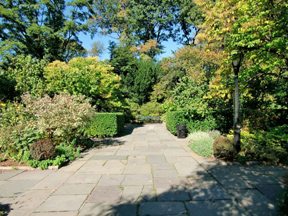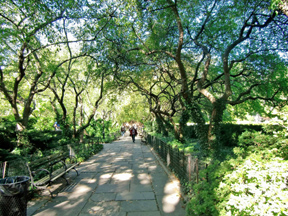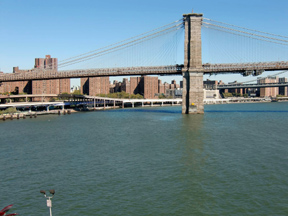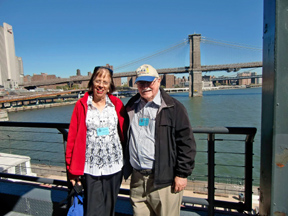EXPLORING NEW YORK – MANHATTAN UNDER A MICROSCOPE (PART 1)
EXPLORING NEW YORK
This is the third in a series of articles about traveling the byways of New York State
MANHATTAN UNDER A MICROSCOPE (PART 1)
By Charles N. Stevens
Photos by Dolores Seidman
Following the same route as the day before, we emerge from the Lincoln Tunnel for an in-depth look at Manhattan. The day is again sparkling clear with an autumn nip in the air, perfect for exploring every nook and cranny of the city.
Just as it did yesterday, the early sun slants straight down the boulevard, filling it with light, the buildings and cars dark in contrast—a fascinating effect. We pause by some of the old brick tenements, their outside fire escapes rusty and corroded, reminding me of movies I have seen of old New York.
On 50th Street we pick up our city guide and are soon on our way for a close-up examination of Manhattan. We roll by famous places rather quickly—Radio City Music Hall where the renowned Rockettes dance, then the studios of CBS, the Columbia Broadcasting System. Before we know it the green expanse of Central Park is on our left, white, horse-drawn carriages taking tourists for rides along its byways. Joggers follow one after the other on the park paths, since running is a part of the young person’s culture. At several places in the park, among the lawns and trees, are outcroppings of gray rock called Manhattan parque acuatico hinchable schist, the bedrock upon which the city is anchored. Had it not been for this solid base, the concentration of skyscrapers would not have been possible.
After rounding Columbia Circle we come upon Lincoln Center, the cultural focus of New York, with its Opera House, the venue for the New York Philharmonic, The Center for the Performing Arts and the famous Julliard School.
Not far away, as we head back toward Central Park, stands the Dakota Hotel where John Lennon once lived. His wife, Yoko Ono, still reside here. The great archway of the hotel where he was shot is on our left, gas lamps burning on either side, two blue-uniformed guards standing at either side of the entrance.
After turning, we see Central park on our left. This great open space was created out of rocky and swampy land in 1873 as a refuge from the noise and chaos of the city. The park has seven lakes, acres of shrubs, lawns and trees, all interlaced with miles of paths and trails. New Yorkers appreciate their park and use it regularly for strolling, jogging or walking dogs, but the main attraction is to get away from the din of the city.
We pass the Museum of Natural History, the great Cathedral of St. John the Divine and the widespread campus of Columbia University. Even though it is located within the city, the central part of the campus is pleasant with its trees and lawns.
Alongside Riverside Park with blue views of the Hudson River stands Grant’s Tomb. To me it looks much more like a Greek temple than a burial site. Grant’s wife especially loved New York and requested that they be buried here.
It is a short drive to 125th Street, the main street of Harlem. We enter it near where the subway trains emerge into the light and travel over an iron trestle often seen in films. Movie goers might remember “The French Connection” with Gene Hackman, which was partly filmed here in 1971. Harlem has more churches than any other part of New York. We see a few women on their way to church wearing distinctive, spectacular hats. Choirs, bands and the congregation gather in the churches, especially the famous First Corinthian Baptist Church. Visitors can sit upstairs in the balcony to watch the services. We zip by the Apollo Theater where so many black stars began their careers. It is now in the process of being completely restored. Nearby is the towering Adam Clayton Powell State Building. The streets are wide and sunny, and lined with shops, restaurants and churches.
Our first stop is at the north end of Central Park, a part that is not generally crowded. Close by is a lake, Harlem Meer, where a flight of ducks takes flight off the water as though they are miles from a city. It’s good to stretch our legs and inhale the cool fresh air. On our way to the French Gardens we walk along a dappled path beneath arched crabapple trees. The park is sunny and green and full of birdsong, the sounds of the city muted by the trees.
After admiring the formal French Gardens, we walk on to the English Gardens, all the trees and herbs flourishing here common to England. Box hedges form geometric borders while a fountain gurgles near the center of a pond. The beauty of the gardens makes it a popular site for weddings. Other than the formal gardens, the areas around them seem more wild and natural. Birds flit from one tree to another, some working the twigs and branches for insects, their motions setting autumn leaves adrift. It feels as though we walk in a rural setting rather than the center of one of the busiest cities in the world.
Our bus rushes by the Museum of the City of New York, the former home of Andrew Carnegie and the circular Guggenheim Museum of Modern Art. Now you see them, now you don’t.
Turning down 5th Avenue, we note the Metropolitan Museum of Art and become immediately frustrated that we won’t be able to visit it. Nearby are expensive apartments, one of them once occupied by Jackie Kennedy. She sold her apartment for $200,000, but it was later sold for millions. We roll by the Frick Museum, the south end of Central Park, the famous Plaza Hotel and the magnificent Trump Tower. There is so much to see in New York that it boggles the mind.
High-end stores line both sides of 5th Avenue. Sacks 5th Avenue is on one corner not far from St. Patrick’s Church. Diamond and jewelry stores abound..
Concrete lions guard the entrance to the splendid New York Public Library, much of the money for its construction provided by John Jacob Astor who garnered his wealth in the fur trade.
Soon after passing the famous Flat Iron Building, one end very narrow, the other broad, we enter Greenwich Village. Trees planted along the narrow streets soften the angular lines of the buildings. Cafes and tea rooms are everywhere. We roll by ethnic restaurants, fish markets, bakeries and funky shops, all giving us the feeling of a village. The largest store in the area is a pet store, frequented by the many New Yorkers who own poodles and other small dogs. Writers and artists once thrived in Greenwich Village, but as the fame of the place increased and rents skyrocketed, many moved south to the Soho area where rents were cheaper.
(To be continued.)

The gardens of Central Park afford a sanctuary from the noise of the city.

We stroll a dappled shaded by crabapple trees in Central Park.

From the end of Pier 17 we have a nice view of the Brooklyn Bridge.

Author and photographer with the Brooklyn Bridge as a backdrop.



